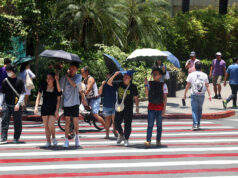Filipino architect infuses his projects with ‘metamodern’ elements
ARCHITECT John Ian Lee Fulgar’s metamodern approach to design is apparent in his projects — the soon-to-be-built Mars Ravelo Museum in Tagaytay City, The Fortress hotel in Angeles, Pampanga.
For the Mars Ravelo Museum, paper-inspired galleries will house works of the legendary Filipino comic book artist. At The Fortress, the hotel will combine medieval and modern themes. Another project, a high-end hotel and casino in Tanauan City, Batangas, will have an origami theme.
Mr. Fulgar believes that art provides the backbone to his creations. He likes working with clients who prefer the unusual over the usual.
Before starting Fulgar Architects, the University of the Philippines-graduate previously worked at Architects 61 Pte., Ltd in Singapore from 2010 to 2014. He was also the president and chief executive officer of web design and development studio CreatingSkies, Inc. from 2009 to 2012.
Mr. Fulgar returned to the Philippines in 2014 to fully focus on his firm. Fulgar Architects is a full services architectural and design firm specializing in “metamodern” design solutions with technological influences.
“Our studio is kind of unique in a way that you have the IT component, the technological component, the designers and engineers working together… We enjoy more of collaborative work,” he said during a media roundtable last Jan. 22.
“The metamodern philosophy is more like a question of what comes after post modernism… We are more facilitated now with things that are digitalized… It has a global age message where everyone is more connected and we have more perspective on what is happening across the globe…. What metamodern now is to help us be more subjective to try to think of a common ground where we can entertain polarities and come up with something new, something creative as a challenge now,” he explained.
Part of the metamodern approach is education, Mr. Fulgar said, “a viewpoint that will look at impact more than the output.”
Mr. Fulgar noted the importance of technology in the firm’s designs and in architecture as a whole, saying it has led to better visualization and better decision making for plans and projects.
“When you work with technology, you are able to visualize the project better kasi [because] it can be, instead of looking at 2D (two dimensional) plans you can actually look at 3D plans and you can section it, you can dissect it, you can walk through it… you could visualize the project better,” he said.
“Because you’re working with building information modelling, you get to work with a lot of data. Data gives you a more empirical approach to design not just preferential. There is a sense of justification… With data you are able to simulate things. You can simulate wind flow, you can simulate traffic, you can simulate circulation, you can simulate solar paths… more empirical analysis involved with technology,” he added.
Technology also gives less room for misinterpretation.
“We’re talking about clear numbers, clear volumes… Back when we were doing manual drafting, it would probably take us five days to a week to finish our quantity take-off, but now due to technology, it’s not far away from a click of a button,” Mr. Fulgar said.
Tweaking details also got a lot easier for architects, thanks to technology.
“There is also a shift in mindset. The good thing about changing mindset is… it is teaching us to look at things holistically first rather than in parts,” he added.
SUSTAINABILITY
More developers are seeking Leadership in Energy and Environment Design (LEED) certifications for their projects. But for Mr. Fulgar, sustainability “has to be a given thing.”
“It doesn’t have to become a celebrated or a new idea because sustainability has been with us since for a long time. It’s just that because of Industrial Revolution, we somehow forgot these and then paved way for a rethinking. Maybe we should be more aware of sustainability, but for us it should be parang [like a] ground rule. It should be part of the design,” he said.
“It’s a non-negotiable aspect because what we do, what we build, how we affect the environment affects all of us… What metamodern’s role is to look at all these aspects from sustainability, to livability, to buildability all of that, and try to come up with new forms and a more technological innovations to come up with better buildings,” Mr. Fulgar said. — Vincent Mariel P. Galang



